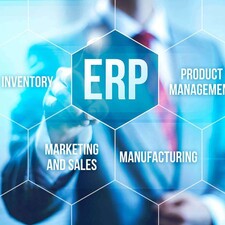Blog
Digital Factories are Shaping the Future of Manufacturing

Summary
The digital factory movement is gaining momentum as manufacturers embrace transformative technologies that are helping them achieve greater productivity and update their business models for today's marketplace. From artificial intelligence to advanced robotics systems, Industry 4.0 is changing the way manufacturers run their businesses, creating opportunities for efficiency and productivity that would be impossible without deep use of digital solutions in the factory.
In simplest terms, the move toward digital factories gives manufacturers the ability to make more informed decisions as they work to optimize operations. This begins with building data into every process and eventually leads to sustained innovation as the lessons learned from that data fuels progress. While the move toward such digital factory systems is already well underway in the form of modern enterprise resource planning systems and Internet of Things projects, transformative technologies could take the movement to another level.
Transformative Technology Drives Digital Factory Innovation
Transformative is a term thrown around a great deal in conversations surrounding digital technologies, but it is more than a buzzword. An IHS Markit study asked business leaders about six technologies the research firm dubbed transformative. The technologies were AI, 5G networks, the IoT, blockchain, cloud computing/virtualization and the move toward video everywhere. Approximately 56% of those polled said these technologies will have a "high-to-significant disruptive impact" in their sectors within the next three years. Just 4% said they aren't expecting such disruption.
Digital technologies are starting to drive major changes in how companies operate. IHS Markit explained that the disruption being driven by today's emerging technologies will likely lead to major operational changes, creating new market opportunities and changing how competition unfolds within an industry.
This is evident in manufacturing, where the digital factory movement is changing many longstanding perceptions. Among major disruptions driving this change are:
- An increased ability for small manufacturers to compete by offering specialized, highly customizable products.
- A heightened use of robotics and software that deepens the role of automation through better real-time data transmission.
- An accelerated adoption of modernized supply chain strategies that reduce operational costs and streamline production.
- A greater capacity for forecasting and inventory optimization to better adapt capabilities to market demands at a given time.
These efforts to drive operational excellence are leading to the move to digital factories as businesses seek ways to create new revenue opportunities in highly competitive markets.
Smart Manufacturing Rises
With disruptive technologies driving a move toward digital factory systems, the larger smart manufacturing industry is rising fast. Smart manufacturing refers to data-driven technologies used to allow for more intelligent, informed decision-making both in everyday operations and for big-picture strategies. In many ways, the idea of the smart factory is interchangeable with the digital factory. Grand View Research reported that the global market for smart manufacturing solutions was valued at $198.21 billion in 2018 . From that point, it is expected to grow at a compound annual growth rate of 10.7% to 2025.
According to Grand View Research, the move to smart manufacturing is evident in a variety of key trends, including:
- Increased digitization across the industry.
- Converged IT and operations technology systems.
- Modernization of legacy control solutions.
The study found that advances in these areas are impacting the entire manufacturing value chain.

Take Steps Toward the Digital Factory
Taking advantage of the cutting-edge technologies transforming manufacturing isn't about a huge one-time project. It is instead a matter of taking a digital journey, making iterative updates and changes to adapt processes, equipment and staffing strategies to better take advantage of digitalization across the manufacturing process. The long-term vision of a digital factory is one in which processes are digitized across the entire business, meaning:
- Sales teams have insight into production data, vendor capabilities and existing supply so they can accurately quote projects and forecast resource availability when speaking with clients.
- Production runs blend robotic processes, additive manufacturing and human interactions to ensure each part of production is handled in the most efficient way possible.
- Testing and quality control systems feature digital imaging and video-based capabilities to provide deep analysis faster, and more accurately, than human testers.
- Warehouse and field services teams have full insights into inventory levels, including items in transit, and that data is easily accessible for stakeholders across the business.
A digital strategy doesn't just incorporate these isolated capabilities. Instead, the data collection and management capabilities across lines of business ensure cohesion and efficiency. This innovation won't happen overnight. It requires iterative progress that builds over time. Steps you can take in this process include:
- Update your ERP system to a future-proof platform designed to be adaptable for the specific workflows created by emerging technologies.
- Implement IoT solutions to solve specific pain points and create immediate value to justify further investment.
- Deploy AI that allows machines to adjust how they function with minimal human intervention.
- Equip staff with modern devices that ensure they have easy access to the data they need to create value in digital factory settings.
Manufacturers can't simply sit back and wait for the digital factory movement to mature. Instead, it's vital to start taking steps now to keep up with innovation in the sector. We can help you on that journey with an ERP system designed with future needs in mind.
Looking for new a ERP system? Download the guide: Selecting an ERP System in 7 Easy Steps
Contact abas ERP today to learn more.


